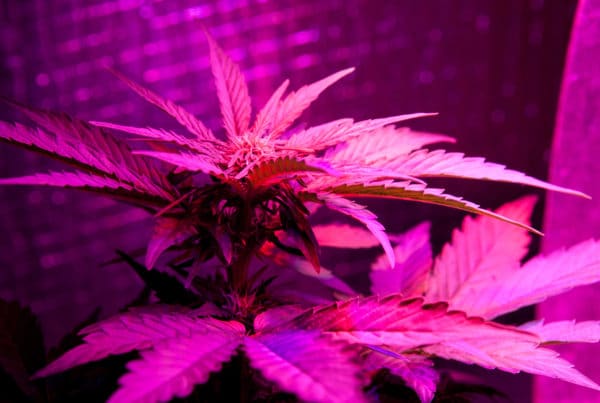Medical Marijuana Cultivation Training Nevada
Quantum 9, Inc. offers custom medical marijuana cultivation training from the worlds most talented cultivators including Ed Rosenthal and Justin DeAngelis. Our custom 10 day training course is unparalleled in the industry.
Training begins once employees have undergone orientation and will vary in length depending on needs. Every employee reviews the same training topics to ensure understanding and transition to Quantum 9 cultivation techniques. [1] The following training agenda takes place over the first 6 working days, supplemented by tasks that grow in complexity within the facility over the first 2 weeks of employment. The following course
Day 1: Plant variety, 5 limiting factors growers must regulate, and security
- Growing characteristics of sativas vs. indicas
- 5 Limiting Factors
- Light—How light is affected by space, and both affect yield. Plants draw light from a spectrum broader than the human eye can see, and use different wavelengths for different things. Chlorophyll synthesis peaks at 435 nm and 445 nm in the blue spectrum and 640 and 675 nm in the red wavelengths.
- CO2—plants only use this in the presence of light. Necessary for photosynthesis, which stops when CO2 concentration is at 200ppm, no matter any other conditions. Must be released just above the plants as the gas is heavier than air and will sink.
- Water—Key measures: alkalinity (the ability of water to buffer acids), its pH (a measure of the acid-alkalinity balance: 5/5 to 6.5 in soil and 5.6 to 6.3 in hydro) and its content of dissolved minerals: 125-150 ppm is a good starting point for water reading.
- Temperature, Humidity, & Air Quality: Ideal temp is 70° to 85° degrees. The more light, the higher the temperature tolerance. Temperatures outside of this range stress the plant and encourage male development. Root temperature is important too and should be kept warm. Ideal humidity is between 40-55%. Air quality impacted by dust can affect the efficiency of photosynthesis as it blocks light and clogs the stomata through which plants exchange gasses/negative ions
- Nutrients and Fertilizers: [2]
- Macronutrients—nitrogen (N), phosphorus (P), and potassium (K).
- More nitrogen during vegetation, more phosphorous during flowering, and the most potassium after fertilization to aid seed production.
- Micronutrients: calcium (Ca), sulfur (S), and magnesium (Mg)
- Usage varies by growth stage.
- Organic standards[3]
- National organic standards set by the United States Department of Agriculture Organic Foods Production Act of 1990.
- Compost Teas and Foliar Feeding thru stomata
- Increase absorption, up to 95% of fertilizer vs. 10-20% using conventional methods
- Health Safety & Security: [4]
Day 2: The Growing Cycle part 1: Soil Prep to Pre-flowering [12]
- Soil—Groundwater level and permeability of the lower layers are most important.
- Drainage
- Vermiculite, perlite, peat moss, coir (coco), bark.
- Mycorrhizae: fungi that live in soil and share a symbiotic relationship with plants.
- Found in the rhizosphere: the area surrounding the roots where water and nutrients are absorbed.
- Increases nutrient uptake
- Provides protection from pathogens and root predators
- More efficient water usage including reduced drought stress.
- Improves quality and yield
- Grows through the plant cell wall and positions themselves between the cell wall and membrane
- Develops a fine network of filaments that serve as an extension of the root hairs.
- Uses electrochemical reactions to dissolve nutrients.
- Transplanting
- 8 oz. container for 7-10 days after germination
- 16-32 oz container for 10-20 days
- 1 gallon for 15-30 days.
- Seedlings/Cuttings—nutrient needs are minimal
- Vegetative growth—begins with the appearance of firm, turgid leaves, and new growth. Maintain an 18/6 light pattern for maximum growth. Some darkness has shown to increase node production. Length of the stage may vary for each strain to reach its maximum output potential in flower, but typically runs 3 weeks in commercial gardens.
- The focus is on high nitrogen (N) fertilizer regimen until flower cycle
- Foliar feeding enhances growth and is absorbed quickly.
- Pruning, bending, lollipopping, and super cropping used at this time to increase yield and control shape by getting light to more of the plant, maintaining fan leaves where possible to maximize metabolism and tissue growth by turning light into chemical energy. [13]
- Photosynthesis
- Water and carbon dioxide combine to release oxygen into the atmosphere and produce sugar to power metabolism.
- Light cycle changes to 12/12. Monitor first 5 days. Plants will begin to show sex 3-4 days after changing the light cycle. The focus is now on phosphorus absorption
- Week 3
- Plants will be 25-50% larger than at this point at the end of the flowering cycle.
- Week 4
- Odors become more prevalent. Focus turns to checking air filtration and odor prevention and monitoring for nutrient excess or deficiencies.
- Week 5
- Same as week 4 cont’d
- Week 6
- Growth starts to slow in 7-week varieties. Calyxes begin to swell.
- Week 7
- The odor is intense. Calyxes swell to near bursting. Identify growth stage to curb self-pollination and prevent pollen dispersion. Monitor trichome growth and color ratios closely for optimal timing.
- Week 8
- Flowers are ripe by end of the week. Peak harvest zone is 72 hours to avoid deterioration.
- Remove all fan leaves to increase circulation and hang plants on a line by strain in a dark room until stems almost snap when bent. When this occurs, the bud is ready to be trimmed. Drying time varies by region and will range from as little as 3-4 days in dry climates like Colorado to 7 or more days in humid climates like Washington State.
- Trim crews vs. trim machines
- Wet vs. dry trim
- Freeze-drying
- Storage
- The post-harvest workspace will include holding area, processing area, and curing-drying area. Processing area is used for manicuring. It will have separate areas for the unprocessed and processed bud, as well as for the trim and fan leaves, which should not be thrown away, but sorted for further processing.
- Always move buds as little as possible to prevent resin from falling off.
- Drying room should have excellent air circulation. Ventilation fans provide cool, dry air, and dehumidifiers remove the moisture.
- Cells retain moisture and convert complex carbohydrates back to simple sugars and break down pigments, including chlorophyll. As chlorophyll is metabolized, the bud turns a lighter shade of green. Other pigments, formerly hidden by the chlorophyll, become apparent, coloring the bud with red, yellow, and purple highlights.
- Buds can stay alive for up to 3 days, continuing some life processes. They gradually lose moisture, and after a few days, all of the cells have died.
- Buds dried too quickly without curing retain more chlorophyll. This is what gives the smoke a grassier taste and aroma, and harsher smoke.
- Only buds that are cured properly and dried slowly have a clean taste, intense smell, and ideal texture of fine herb.
- Humidity needs to be regulated so it stays between 45-55%.
- Excessive humidity promotes mold
- Insufficient humidity—40% or lower—promotes drying and stops the curing process.
- Bud size, the ratio of drying space to the amount of bud, temperature, and humidity all affect drying time.
- Hang plants upside down on strings. Fans create a draft that promotes evaporation, and ventilation exchanges the moist air for dryer air.
- Mold appears when there is too much moister in the air.
- Quickly decrease humidity to 40% or less and increase temperature to 75° Fungi and molds prefer cool temperatures and stop growing in warm conditions.
- At 50% humidity, buds gradually dry over a week or two
- Lowering humidity to 40-20% quickens dry time.
- Set air conditioning to 65° If the temperature is warmer outside, the a/c will remove water from the air.
- Heat the room using a dehumidifier. The 2 appliances oppose each other in temperature, but both remove humidity, making it easier for more water to evaporate from the plants.
- Heat-dried bud loses the more volatile terpenes during processing. It hastens the process, but these odor molecules that give marijuana strains their personalities evaporate between 70°-85°
- Quickly dried buds are not as fragrant and create an uneven dry. The outside dries crisp while the inside remains moist.
- Quality improves for several weeks after bud has dried because THC acid loses its water molecule and becomes psychoactive.
- Wet bud
- Will not get you as high as dry bud because some of the cannabinoids have not become active.
- If packed moist is prone to mold or rot.
- Bud infected with powdery mildew or other mold is unfit for smoking.
- Packed moist bud under warm conditions will activate bacteria, releasing an ammonia smell once the oxygen is depleted.
- If packaged bud starts sweating or creating condensation, the buds are too wet and need more dry time.
- Best taken during vegetative growth stage, but can be taken up to harvest.
- Cuttings root within two weeks when given a clean, humid, moist, and warm environment.
- Without roots, cuttings have limited ability to absorb water.
- Keep humidity between 75-85% so plants are not stressed.
- The temperature should be kept between 80°-85°
- Lower temperatures inhibit root development.
- Like seedlings, cuttings require only moderate light, about 10-15 watts per square foot. Once rooted, they will require twice the light.
- Most professional cloners prefer Rockwool.
- Cloning machines use aeroponics or aerated water instead.
- Cuttings are best taken from new growth at the ends for the branches as plants naturally push nutrients there.
- Used to create millions of copies in a short time inexpensively.
- Ideal for sharing and transporting crops. Tissue culture clones are shipped around the world by the thousands. It creates an opportunity to improve cannabis crops genetically.
- Node cuttings rooted in small jars on a nutrient gel made of sugar, agar, and plant hormones (same hormones used for cloning cuttings).
- Sterile culture keeps these clones pest and disease free.
- Typically produces five to eight new plants every four to six weeks.
- When plants reach .75” or larger they are removed for rooting.
- Once in jars, the plants have all of the resources they need to grow by themselves.
- When new plants fill the jar, the largest plant pieces, the micro clones, are cut from and planted in a larger rooting tub to give the plants room to spread out and grow.
- Remaining base of undeveloped plants is moved to a new multiplying jar.
- “Deflasked” clones, like regular clones, are kept under a humidity dome for a few days until they develop a protective waxy coating, or cuticle. The plants root over a few weeks until they are ready to transplant.
- The containers limit plant size. Sugar provides energy and supports growth, hormones steer growth toward branching or rooting, and preservatives keep it all clean.
- Byproduct/Trash:
- Fan Leaves THC content 1-3%
- Trim THC content 2-6%
- When trim and leaves are tossed, 10-20% of the plant’s total THC production is thrown away.
- Processed for concentrate, kief, hash, tincture, butter, or food
- If you are going to use it, it should be sorted. Stems and woody parts are not salvageable.
- Understand and follow local regulations in disposal protocol for marijuana waste
- Stress from light, disruption, or over-pruning will encourage hermaphroditism
- Overwatering
- Underwatering
- Nutrient burn
- Nutrient deficiency
- Pests[15]
- Approved pesticides[16]
- Seeds vs. Clones—disease and pest free and germination and downward taproot growth vs. transference, genetic consistency, sinsemilla, and lateral root growth
- Feminized seeds: induce a normal female to grow male flowers with viable pollen using chemical agents like gibberellic acid 3, silver nitrate, or silver thiosulfate to cross with another female. These agents inhibit production of ethylene, without which female flower production is reduced or stopped. The resulting seeds can only inherit two X chromosomes, resulting in almost all females. Fortunately, the effects of these chemicals are localized, and the rest of the plant will continue growing female flowers. Male flowers will appear within two weeks, and pollen is ripe in another two weeks.
- Soil vs. Hydro
- Strain selection for finishing time, yield and medicinal traits
- Mother plants vs. perpetual cloning
- Mold appears when there is too much moister in the air.
- Drainage
Day 3: Flowering cycle part 2
Day 4: Harvest, Trimming, Curing[14]
- Harvest
- Trimming
- Curing
- Drying
Day 5: Cloning and Restarting the Garden
- Clones
Step by step guide to cloning located in Part V Harvest & Beyond: restarting the garden
- Tissue Culture
Day 6: Problem Solving—Pest, Disease, Appendix & FAQ
Day 7: Compliance and Procedure
- Inventory training[17]
- Labeling and packaging standards[18]
- Quality Control[19]
- Mandatory disclosures[23]
- Soil Amendments and fertilizers applied to lot
- Name of independent testing laboratory
- Test Results
- Batch tracking required information[24]
- Batch Number
- Seeds or cuttings
- Strain name
- Number planted
- Date planted
- List of chemical additives
- Pesticides
- Herbicides
- Fertilizers
- Number of plants grown to maturity
- Harvest Information
- Date of harvest
- Final yield weight of processed usable marijuana
- Name and agent registration card number for person responsible for harvest.
- Disposal[25]
- Date of disposal
- “Unusable” Confirmation
- Method of Disposal
- Name and agent number responsible for disposal
Days 8-10: Reinforcement
The goal is to provide exposure and build confidence in all the subjects outlined over the first 2 weeks of employment. New hires are encouraged to use the last few days of the program to seek additional assistance and pace their competence with the training expectation. Agents are responsible for all the information outlined after their first 2 weeks.
All employees will undergo a 30-day evaluation and are encouraged to seek additional assistance/training throughout and beyond their evaluation period. Quantum 9 can conduct annual performance reviews and continue to offer training as needed to ensure efficiency, quality, and compliance.
Footnoted Nevada Regulations
[1] Adopted Regulation R004-14: NAC 453A.41 §6b (2014)
[2] Adopted Regulation R004-14: NAC 453A.41 §6 (2014)
[3] Adopted Regulation R004-14: NAC 453A.70 (2014)
[4] Adopted Regulation R004-14: NAC 453A. 104 (2014)
[5] Adopted Regulation R004-14: NAC 453A.61 §§ 1-2 (2014)
[6] Adopted Regulation R004-14: NAC 453A.41 §6e (2014)
[7] Adopted Regulation R004-14: NAC 453A.41 §3c (2014)
[8] Adopted Regulation R004-14: NAC 453A.72 §3 (2014)
[9] Adopted Regulation R004-14: NAC 453A.41 §3 (2014)
[10] Adopted Regulation R004-14: NAC 453A.41 §3b (2014)
[11] Adopted Regulation R004-14: NAC 453A.72 §2 (2014)
[12] Adopted Regulation R004-14: NAC 453A.41 §6a (2014)
[13] Adopted Regulation R004-14: NAC 453A.41 §6a (2014)
[14] Adopted Regulation R004-14: NAC 453A.41 §6d (2014)
[15] Adopted Regulation R004-14: NAC 453A.41 §6c (2014)
[16] Adopted Regulation R004-14: NAC 453A. 120 §9 (2014)
[17] Adopted Regulation R004-14: NAC 453A.57 §3 (2014)
[18] Adopted Regulation R004-14: NAC 453A. §§ 74-79 (2014)
[19] Adopted Regulation R004-14: NAC 453A. 103 (2014)
[20] Adopted Regulation R004-14: NAC 453A. 120 §a (2014)
[21] Adopted Regulation R004-14: NAC 453A. 115 (2014)
[22] Adopted Regulation R004-14: NAC 453A. 115 §2 (2014)
[23] Adopted Regulation R004-14: NAC 453A.71 (2014)
[24] Adopted Regulation R004-14: NAC 453A.41 §6 (2014)
[25] Adopted Regulation R004-14: NAC 453A.41 §6c (2014)







